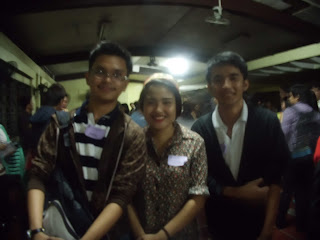Does it make you less
of a Filipino to boast for a wishful desire in having blue eyes and blonde hair
on a white Christmas holiday?
I know that there are
many Filipino people of my age who are deadly fanatic to Western culture. A
friend of mine was even excessively proud to showcase his Italian scent of perfume.
More than that, I cannot even fathom how arrogant those some parents who avoid speaking
Tagalog or using the mother tongue towards their children when they give
instructions. For me, there is nothing more of being a Filipino than
appreciating our own language and a satisfied consumer on a brand made in the
Philippines. Of course, this is too simple but I will initially settle on this.
It is extremely important to establish one identity that binds the fragmented view of being a Filipino. It is only through our sense of nationalism that we foster cooperation in advancing our country from the rank of being a 3rd world state. All Japanese can identify themselves as Japanese, so as Chinese, Europeans, and Americans. All of them enjoyed at the helm of being politically and economically developed countries. With nationalism, we care for what concern the others. We eventually establish sense of belongingness to others whom we proudly identify as a Filipino. But who we really are? And what is it to be a Filipino?
It is undeniable that the ever patriotic message people resort to is by citing Rizal’s undying view on “whoever knows not how to love his native tongue is worse than any beast or evil smelling fish” and also the known “tangkilikin ang sariling atin”. However, several thoughts can easily dispute this idea about patriotism on whether it is widely practiced or not.
What really makes us say that we are Filipinos? Most students’ answers will be then based on physical appearance. We proudly recite that Filipinos have a “kayumanggi na balat”, which our elementary teachers would dictate us. Given this, how about the same feature among the Thais, Cambodians, or even the Vietnamese? Even if we think more distinct features that can separate us from the other nationalities in the world, we still can hardly identify on who we really are.
We Filipinos indeed do not have a unique physical appearance that set us apart from our brothers and sisters in Asia. We cannot solely claim that our beliefs of being Filipino are exclusively for us. Nevertheless, the issue that matters is on how to be a genuine Filipino that our forefathers whished us to be. Living with the illusions of possessing foreigner’s appearance was not the promise of Rizal for us, neither with Bonifacio, and nor with those all heroes listed on our history books.
For one to be a Filipino, we must be able to look beyond on what is reserved for our beloved country. We may learn from our haunted experiences from the past but must keep moving forward. Like the historical EDSA People Power 1, youths of today must learn how the attitude of unity and courageousness chained the people to march and topple the government. This indeed makes us appreciate social cohesion against a repressive regime. But what is truly happening right now only reflects the disappointments that our grandparents experienced years back. Some of our leaders continue to corrupt as a practice that long time ago plagued our government. If we already saw the impact of corruption in the society then our elected officials must move forward and keep away from this crime.
For one to be a Filipino, we must be able to help one another in building a one nation that promotes a culture of peace, a nation that will surely never break. But the current situation defeats the dream of our heroes. A Filipino nation has been contested. Some critique on the Imperial Manila and the secessionist Muslims in Mindanao.
For one to be a Filipino we must stand up and talk to what is necessary to discuss in this time when there is a social stress. These are the problems on our judicial system, educational system, our local government units, and other institutions that our heroes had fought for. It is through our discourses and debates that will straighten the road for development.
For one to be a Filipino, we must be able to understand the value of being brave. Our national hero was indeed a walking subversive. Bonifacio’s arm struggle had left a remarkable consciousness to the people too. Many Filipinos during those times willingly gave up their lives for one dream of setting Philippines free from the repressive Spanish government. With today’s problems that we Filipino people are facing, we must live up to what our role as citizens wanted us to be. We must be brave in times when the government is returning to its bad image from the past. Let’s not wait to be victims of impunity, enforced disappearances, and any tools that other entities use to take our rights away from us.
Finally, what is to be perfectly a Filipino is to live up the mandate that our heroes had fought for more or less a century. For me, being a Filipino is more than appreciating our culture and products but simply to live what are we here for- to move forward for our country, to help one another, to speak up, and to be brave enough to fight for what is right. All these are attributed to us by all of our Filipino heroes.


















.JPG)
.JPG)






.jpg)
